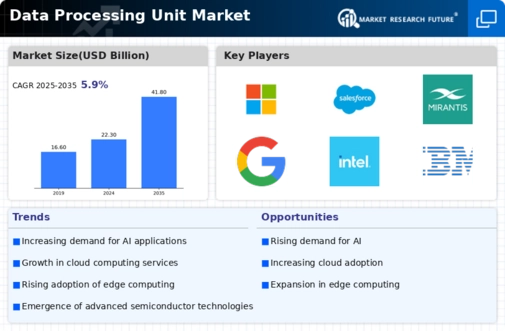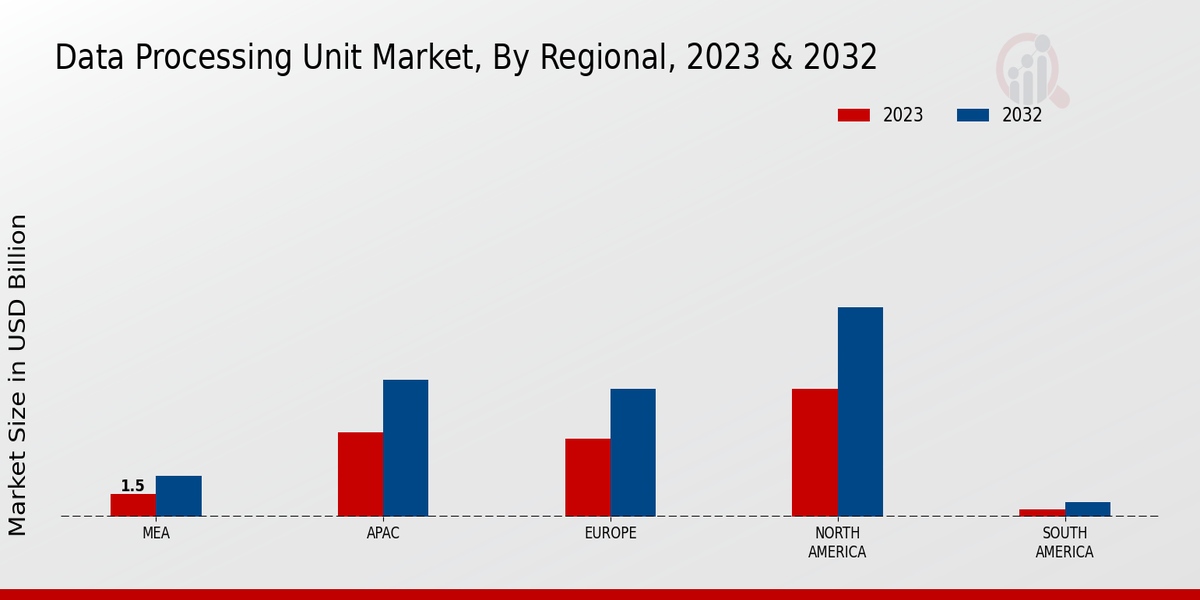Increased Data Generation
The exponential increase in data generation across various sectors propels the Global Data Processing Unit Market Industry forward. With the proliferation of IoT devices and digital platforms, organizations are inundated with vast amounts of data that require efficient processing. This trend necessitates the deployment of advanced data processing units capable of handling large-scale data operations. The market's growth trajectory suggests a compound annual growth rate of 5.88% from 2025 to 2035, reflecting the ongoing need for robust data processing solutions. Organizations that effectively harness this data stand to gain valuable insights and enhance decision-making processes.
Market Growth Projections
The Global Data Processing Unit Market Industry is poised for substantial growth, with projections indicating a market size of 22.3 USD Billion in 2024 and an anticipated increase to 41.8 USD Billion by 2035. The compound annual growth rate of 5.88% from 2025 to 2035 reflects the increasing reliance on data processing units across various industries. This growth is driven by factors such as the rising demand for cloud computing, advancements in AI, and the need for efficient data management solutions. As organizations continue to prioritize data-driven decision-making, the market is expected to expand significantly.
Rising Demand for Cloud Computing
The Global Data Processing Unit Market Industry experiences a notable surge in demand for cloud computing solutions. As organizations increasingly migrate their operations to the cloud, the need for efficient data processing units becomes paramount. In 2024, the market is projected to reach 22.3 USD Billion, driven by the necessity for enhanced computational capabilities. This trend is likely to continue as businesses seek to optimize their data management strategies. The integration of advanced data processing units facilitates improved performance and scalability, essential for handling vast amounts of data generated in cloud environments.
Growing Adoption of Edge Computing
The growing adoption of edge computing technologies plays a pivotal role in shaping the Global Data Processing Unit Market Industry. As businesses seek to reduce latency and enhance real-time data processing capabilities, the demand for data processing units that can operate at the edge is on the rise. This shift is particularly evident in sectors such as manufacturing and healthcare, where timely data analysis is critical. The market's expansion is likely to be fueled by the need for localized data processing solutions that minimize bandwidth usage and improve operational efficiency. This trend aligns with the broader movement towards decentralized computing architectures.
Advancements in AI and Machine Learning
Advancements in artificial intelligence and machine learning technologies significantly influence the Global Data Processing Unit Market Industry. As these technologies evolve, they require more sophisticated data processing capabilities to analyze and interpret complex datasets. The market is expected to grow as organizations invest in data processing units that can support AI workloads. This growth is indicative of a broader trend where the demand for high-performance computing solutions is projected to increase, potentially reaching 41.8 USD Billion by 2035. The ability to process data efficiently is crucial for organizations aiming to leverage AI for competitive advantage.
Regulatory Compliance and Data Security
Regulatory compliance and data security concerns are increasingly influencing the Global Data Processing Unit Market Industry. Organizations are compelled to invest in data processing units that not only enhance performance but also ensure compliance with stringent data protection regulations. This focus on security is particularly relevant in sectors such as finance and healthcare, where data breaches can have severe consequences. As a result, the market is witnessing a shift towards data processing solutions that integrate robust security features. This trend underscores the importance of balancing performance with compliance, driving innovation in the development of secure data processing units.























Leave a Comment